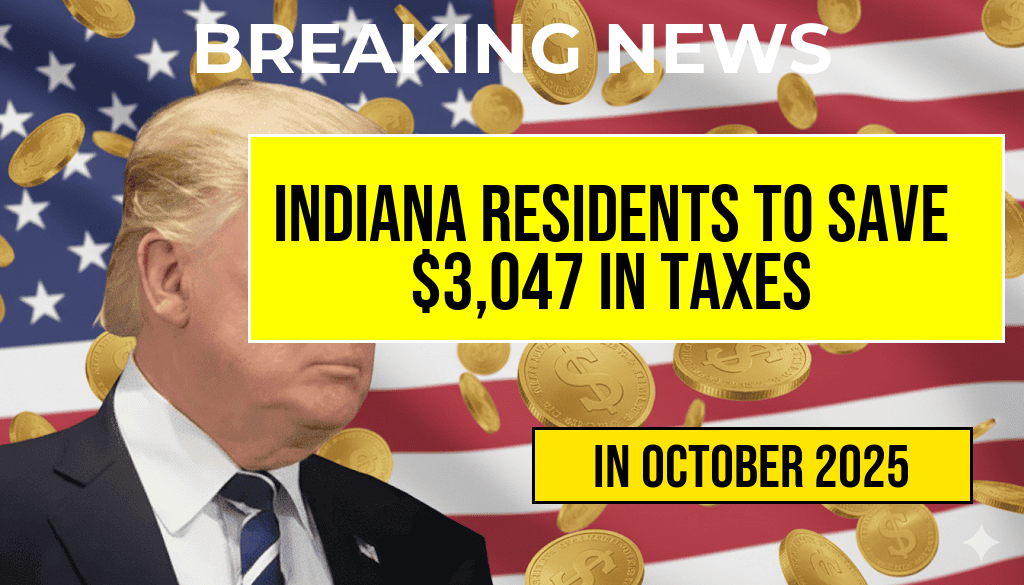Residents of Indiana are poised to see notable tax savings starting in 2026, with projections indicating an average reduction of $3,047 per household. The new legislation, passed by state lawmakers earlier this year, aims to overhaul the state’s tax code by implementing targeted reforms designed to stimulate economic growth and provide immediate relief to taxpayers. Officials estimate that the legislation will impact nearly every household across the state, translating into significant financial benefits over the next few years. As Indiana prepares for these changes, experts suggest that the law could serve as a model for other states seeking to balance fiscal responsibility with increased disposable income for residents.
Details of the New Tax Legislation
Key Provisions and Scope
- Income Tax Reduction: The legislation reduces Indiana’s state income tax rate from 3.23% to 2.75%, effective January 1, 2026. This reduction is expected to save households an average of $1,200 annually.
- Property Tax Relief: Local governments will receive increased funding to offset property tax hikes. Additionally, the legislation introduces a new property tax exemption for first-time homebuyers, potentially saving new homeowners up to $1,000 annually.
- Business Incentives: To complement individual tax cuts, the law provides incentives for small and medium-sized businesses, including expanded tax credits and reduced corporate tax rates, aiming to foster job creation and economic resilience.
Projected Economic Impact
State officials project that the tax cuts will stimulate consumer spending, attract new businesses, and bolster local economies. The Indiana Department of Revenue estimates an overall fiscal impact of approximately $1.2 billion annually, funded through a combination of increased economic activity and careful budget adjustments.
How the Savings Will Affect Households
| Household Income Level | Average Savings |
|---|---|
| Below $50,000 | $1,800 |
| $50,000–$100,000 | $3,047 |
| Above $100,000 | $4,100 |
For middle-income families, the anticipated $3,047 annual tax reduction represents a meaningful enhancement of disposable income, potentially easing financial pressures related to housing, healthcare, and education. Higher earners are expected to realize even larger savings, which could be redirected toward investments, savings accounts, or community contributions.
Public Response and Political Dynamics
Support From Lawmakers and Advocacy Groups
Many state legislators have lauded the legislation as a strategic move to make Indiana more competitive nationally. Indiana’s legislative leaders argue that lowering taxes will attract new residents and businesses, creating a more robust economy. Advocacy groups emphasizing economic development have also endorsed the measures, citing potential for increased job opportunities and improved quality of life.
Critics and Concerns
However, some critics warn that the tax cuts could lead to budget shortfalls, especially if economic growth underperforms projections. Opponents also question whether the benefits will be evenly distributed, raising concerns about increased income inequality. Local governments may face challenges in maintaining service levels if state revenue growth does not meet expectations.
Implementation Timeline and Future Outlook
The legislation will take effect with the start of the 2026 fiscal year, with initial changes reflected in tax filings due in April 2027. State officials have committed to transparent communication and ongoing monitoring of economic indicators to assess the law’s effectiveness. Experts suggest that the law’s success will depend on sustained economic growth and prudent fiscal management.
For residents eager to understand how these changes will specifically impact their finances, the Indiana Department of Revenue will provide updated guidance and resources as the implementation date approaches. As the state navigates these reforms, the coming years will reveal whether the projected savings translate into broader economic benefits for Indiana communities.
Frequently Asked Questions
What is the main tax savings for Indiana residents in 2026?
Indiana residents are expected to save approximately $3,047 in taxes in 2026 under the new legislation.
How will the new legislation impact Indiana’s overall tax rates?
The legislation is designed to reduce overall tax rates for residents, resulting in significant tax savings by 2026.
Which types of taxes are affected by the new legislation?
The new legislation primarily impacts income taxes but may also influence other state and local taxes to benefit Indiana residents.
When will residents start seeing these tax savings?
Residents can expect to start experiencing these tax savings beginning in the 2026 tax year, following the implementation of the new laws.
Are there any eligibility criteria to benefit from the tax reductions?
Generally, the tax reductions apply to all eligible Indiana residents, though specific criteria may vary, so residents should review the details of the legislation for eligibility.








